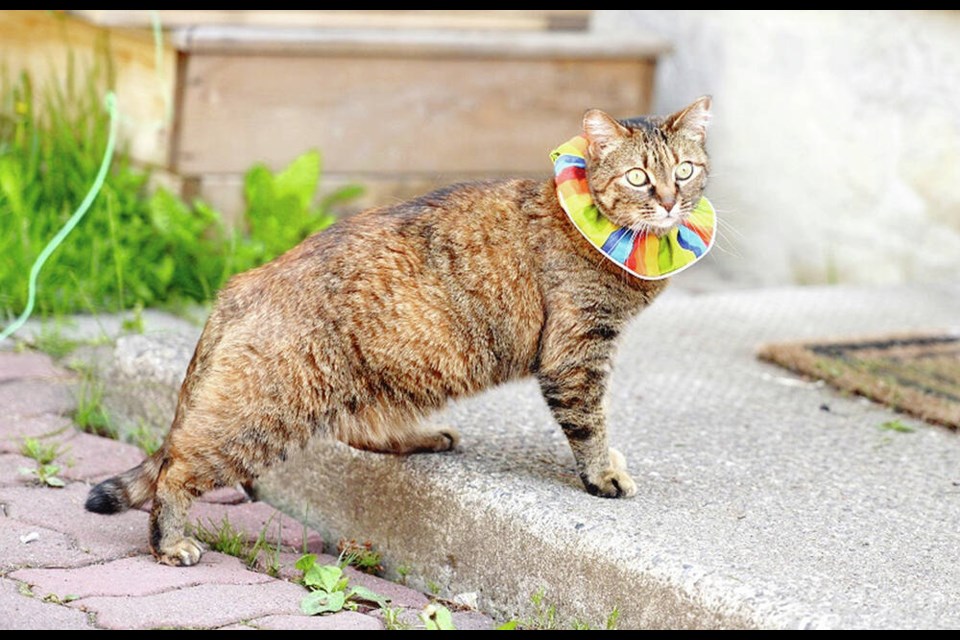Colourful collar covers can provide an early warning system for birds against stealthy free-roaming house cats, which are being blamed for killing millions of birds each year in Canada.
Experts say the bright fabric tubes that slip over cat collars — sold under various brands and looking a lot like a hair scrunchie — give birds a chance to escape a cat’s lethal pounce and work better than bells.
Birds have a vivid sense of colour that is even better than humans, said Ken Otter, a biologist and chair of the University of Northern British Columbia’s department of ecosystem science who did a study on the collars and bird mortalities.
Otter said cats often lie in wait, silencing their bells, for ground foraging songbirds like sparrows and robins to come close enough to grab. With the rainbow-coloured collars, birds at least have a chance, he said.
Otter said birds have four colour-sensing receptors in their eyes detecting ultraviolet as well as reds, blues and greens — more than humans and other mammals — so the flash of colours gives birds an opportunity to react.
“The collars did prove effective,” said Otter. The study used 14 house cats and their owners over several months in Prince George, with initial results showing that cats wearing bright collar covers brought home fewer dead birds than cats without them. The study was put on hold after COVID-19 struck, and was not continued.
Domestic and feral cats are considered the No. 1 killers of birds in Canada, taking between 100 million and 350 million — far greater than window collisions, according to a 2013 study by Environment Canada scientists published in the Avian Conservation and Ecology journal.
The estimates, based on 8.5 million pet cats in Canada, indicate the majority of those kills are likely caused by feral cats. However, the research reveals cats are the largest “human-related sources of mortality for wild birds” and have contributed to an overall decline in bird populations. Canada’s wild bird populations are estimated to have declined about 12 per cent in the past 40 years, with some populations decreasing by over 95 per cent, due to all sorts of causes, including climate change that decreases food sources.
South of the border, the American Bird Conservancy estimates outdoor cats kill 1.4 billion birds a year.
Ann Nightingale of the Rocky Point Bird Observatory said bird deaths caused by cats are common and preventable. She said while some cats bring home their unpleasant surprises to pet owners, many more don’t or leave birds wounded to die later.
“Let’s assume they are overstated … what is an acceptable number?” Nightingale said. “If there are 93 million pet cats in North America — and each one takes one bird, that’s still 93 million birds a year, or each cat takes two birds that’s nearly 200 million. That’s completely outrageous.”
She said birds already have it tough enough out there in urban environments with building development eating up habitat and food sources, pesticide use, increasing auto traffic and transmission wires.
Nightingale said cats face significant dangers themselves when roaming free, including predation by wild animals such as cougars and coyotes and being run over by vehicles.
She advocates for keeping cats indoors, building outdoor enclosures or taking them out on leashes.
”Interestingly, cats are the only pets that we would consider sending out on their own … we don’t do that with dogs,” said Nightingale.
Off-leash dogs also pose a problem for birds, particularly on beaches and shorelines, said Nightingale. “Dogs chase migratory birds who have flown thousands of miles to the point of total exhaustion.”
Most communities have bylaws for cats, though enforcement is driven by complaints, said Ian Fraser, manager of Animal Control Services that operates in Victoria, Esquimalt and Oak Bay, and has contracts in Nanaimo.
Bylaws state that any pet — and that goes from cats and dogs to gerbils and snakes — can’t trespass on private property without permission and can’t be in a public place unless under direct supervision, said Fraser.
Owners are usually given a warning; cats can be impounded and owners issued municipal tickets. In Victoria, the fine is $150 and Esquimalt is $75 while in Oak Bay it’s impoundment only.
Nightingale said bird mortalities due to pets “is a people problem that can be avoided.”
If cat owners won’t put on the colourful collars and still insist on letting their cats out, Nightingale suggests they at least keep their cats indoors during peak bird feeding times, which is usually the first few hours around sunrise and the two hours before the sun sets in the evening.
That’s when birds are getting food on the ground and flying it back to their nests.
Breeding and nesting season on Vancouver Island goes from mid-March to late July for many species, making birds even more susceptible to cat attacks as they forage for food and nesting materials.
Nightingale also cautions people out doing yard work, like trimming hedges and raking debris, because several species of birds such as towhees, warblers, some sparrows and juncos build nests in the ground or in low shrubs and flower pots.
Chris Poier of Wild Birds Unlimited said the company has the colourful cat collars at its Shelbourne Plaza location and they are proving popular. “We’ve had people who don’t have cats buying them for their neighbours,” he said. “The birds have it tough out there in the city, with a lot of their habitat and food sources mowed down by development.”
Otter said the collars used in his study, BirdsBeSafe, are available online and many pet owners make the collar covers themselves.
The bright collars showed no effect on a cat’s ability to catch rodents during the Prince George study. Otter said rats and mice have blue-red colour receptors in their eyes, so they likely weren’t picking up on the bright colours of the collar covers.
>>> To comment on this article, write a letter to the editor: [email protected]



